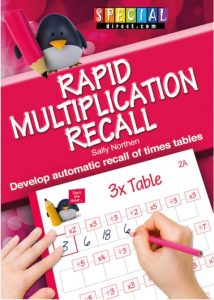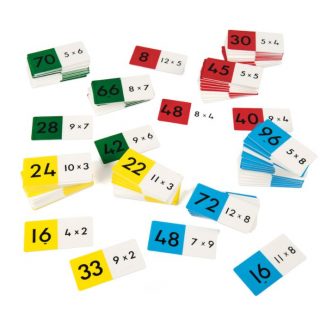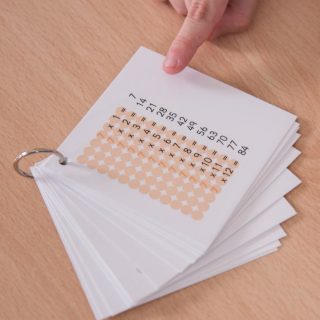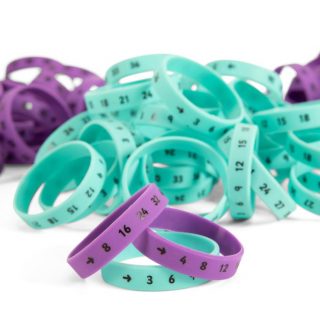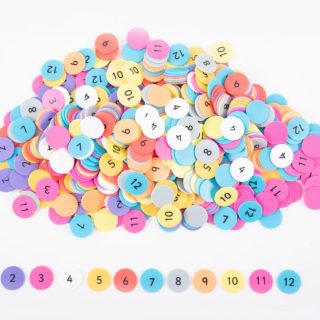Here are 13 ideas that might just help – because with something that can be so repetitive it’s good to have as many different strategies to draw on as possible.
- Counting sticks are an invaluable tool for daily whole-class teaching and practise for all ages. They make a great focal point and allow the whole class to participate and learn together, promoting confidence and flexible thinking.
When teaching a new times table, begin by displaying each multiple and count up together in different ways.
e.g.
As children become more confident, remove some of the numbers and eventually, all of them.
Point to any line. “If this is the 8 x table, what number would be here?”
“How many eights is this?”
- Origami cootie-catchers/fortune-tellers
Children love making these and they will even want to practise tables at playtime! If you have forgotten how to make them, download a template here. Children choose 4 numbers for the top layer (depending on which tables they need to practise) then add numbers 2 – 9 to the second layer. On the very inside they can either write the four possible answers and/or a positive message for when the correct answer is given, e.g. ‘You are a times-table wizard!’ or ‘You are a star!’ etc.
This photocopiable book is a great tool. It is incredibly clear and simple and looks friendly (with a penguin motif on each page). Every page includes division so that the understanding of the inverse is built in.
The great thing about using a book like this is that children can all do a page at the same time but it can be at their own level. They keep their own scores and times and can challenge themselves to better them. Children can be working on the same table if you are all starting it together, or whichever ones they need to practise.
- Individual sticker charts
Everybody loves a sticker and it’s incredible how motivating they can be! Make simple charts so that each time children do a table test, and get, for example, more than 10 out of 12 they get a sticker to add to it. Maybe there could be a bigger reward when the chart is full – a certificate given in assembly or perhaps 20 minutes of a favourite activity.
- Singing or rapping
There are many times-tables songs available on YouTube and CDs with songs and backing tracks to help learn multiplication tables. This way of learning can be very appealing to children who might struggle with memory and will certainly help to make maths lessons lively!
- 100 square patterns
Using 100 squares, investigate patterns made by different times tables. Show different patterns without numbers. Can children say which tables they represent? Try finding patterns on different sized squares, such as 6 x 6, 7 x 7 etc.
Dominoes make a great game for independent practise and many can be downloaded for free if you search online.
These dominoes are particularly useful at the moment because they can be thrown into soapy water and washed. They are colour-coded into separate tables but can also be combined.
- Tables Treasure Hunt
Choose a table you want to practise (for example the 6s).
Place 12 envelopes in different positions, perhaps in an outdoor area. On each envelope is the answer to a times table and inside is the clue to the next. Begin by finding the envelope showing the number 6.
Inside it may say 5 x 6, so next, they have to find the envelope showing 30. The final envelope may contain stickers as a reward, or perhaps a clue to somewhere else to find a different reward or activity.
- Back-to-Back game
Choose two children to stand up back-to-back (with a little distance between them at the moment). Either the teacher or another pupil shouts out a times table question. The first of the two children to answer stays where they are and the other person sits down. A new volunteer then stands back-to-back with the champion and so it continues!
- Multiplication Keyrings and Wristbands
Both of these are quite new and are wonderful resources to be able both to use in school and to send home with children.
The keyring cards have dual representations of the tables both as colourful arrays and as numbers. They can be added to the keyring as new tables are introduced.
- The wristbands can offer discreet support in the classroom or perhaps serve as a whole school reward scheme.
Ask the child to close their eyes, turn the wristband then pinch it when you say stop. Open their eyes. What number is their finger on? Together, count up to that number. Which two factors make this product?
This is another new idea, certainly worth trying with children who don’t understand the nature of multiplication as repeated addition and who might still benefit from using concrete representations. Each table is colour-coded, so for example, you might be working on the 3 x table and say, “Can you show me 4 x 3?” The child would then lay out the counters to represent this. There are enough counters to show the whole array up to 12x.
- Egg boxes
Write the answers to any of the times tables on small pieces of paper. E.g. 3 x table – 3, 6, 9, 12, 15 etc. Put one in each egg box space, out of order.
- Call out the times table you wish to practise. You might do it in order first. Children should put an object, such as a cube, in the correct answers as you go.
- As above, but put answers to your chosen times table in order and cover them up with a cube in each. “Where will 3 x 3 be?” “What number will be under that cube?” Children choose a cube and pick it up to check the number underneath to see if they are correct; if so, they keep it.
It would be wonderful to hear some of your own tried and tested methods. Please tag us in your posts on social media if you have any more suggestions!



